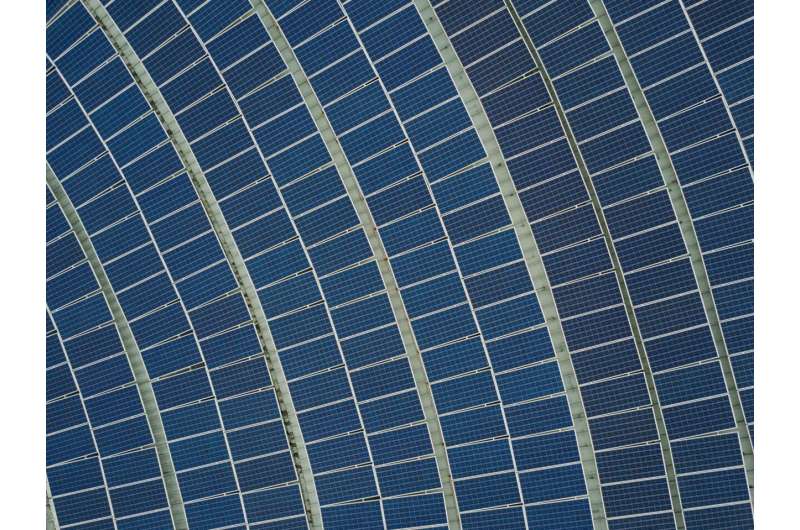
Philadelphia has begun pulling large amounts of power for city-owned buildings from a solar array on farmland near Gettysburg.
The project, begun nearly six years ago under former Mayor Jim Kenney, started producing electricity specifically for the city a few weeks ago in Adams County after testing was complete. It is expected to provide up to 25% of power consumed by municipal buildings, including City Hall, Philadelphia International Airport, and the Water Department.
Philly is under contract to purchase 70-megawatts of power annually from the array.
"We're feeling great about this project," said Dominic McGraw, Philadelphia's deputy director of energy services. "It's been a long time coming. We're very excited to move forward."
How does Philly get the electricity?
Under the arrangement, city-owned buildings get power from the panels, although not directly. Rather, the array—the collection of solar panels—feeds to a substation that sends power to the regional grid operated by PJM, which coordinates electricity regionally across multiple states including Delaware, New Jersey, and Pennsylvania. The power is then delivered to Peco territory for use by Philadelphia.
The city owns about 600 buildings. It has a contract to buy solar-generated electricity for those buildings at $44.50 per megawatt hour for 20 years from Energix Renewables, the project's developer. The rate was established when the project was proposed in 2018. The energy produced by the solar array is not meant to power any homes or businesses in the city.
McGraw said the rate is comparable to what the city has paid on average the past three years.
The array sprawls across 700 acres in Straban Township, Adams County, Pennsylvania. It was built by Arlington, Va.-based Energix Renewables on farmland about three miles from Gettysburg.
Kenney originally announced the effort in 2018, with a goal of supplying energy by 2020 or 2021 as part of a strategy to combat climate change. The plan was part of the city's goal to power 100% of its electricity from renewable sources by 2030. Various events delayed the plan, including supply chain issues that resulted from the pandemic.
McGraw said the city plans for more energy projects to fulfill that goal.
Originally, the city expected to pull about 22% of its power from the array. But McGraw said various energy conservation programs started since 2018 have reduced the amount of power the city uses.
"We've been able to reduce it enough that solar will now count for about 25% of our total load," McGraw said, nothing that officials won't know the true amount until the year is over.
How big is the solar project?
Installation of the array, which includes about 230,000 solar panels across 1,200 acres, was completed in November, according to Itamar Sarussi, Energix's Country Manager.
The substation, which takes the power, regulates the voltage, then transmits it through connecting lines, became operable in December, and the project was able to connect to the grid.
Workers had to finalize settings for the substation's controls and inverters, which convert the direct current produced by the panels into alternating current, which is what is used to power homes and offices. The array also has meteorological stations that provide weather information.
Overall, the project has capacity to generate more than 150,000 megawatt hours annually of clean energy.
"Energix is excited to be powering the City of Philadelphia," Sarussi said in an email. "This project helps reduce carbon emissions and mitigate climate change, and ultimately ensures a brighter future for generations to come."
City officials, including Mayor Cherelle L. Parker, are hosting a celebration of the project's completion on Tuesday. She'll be joined by representatives of the city's Energy Authority and Office of Sustainability, as well as Energix Renewables.
Penn's solar project
It is not the biggest use of solar in Philadelphia, however. The University of Pennsylvania announced in March that it had begun purchasing power from an array set on 1,600 acres in Fulton and Franklin Counties. That project, Great Cove I and II, has 485,000 panels. Penn officials say it has the capacity to produce 220 megawatts annually, making it the largest solar project in the commonwealth.
Penn says electricity from the Great Cove project will meet 70% of the demand of its campus and University of Pennsylvania Health System facilities in the Philadelphia area. It has an agreement to buy the power from Community Energy, which has been acquired by Virginia-based AES Corp. Construction for the project began in April 2022.
2024 The Philadelphia Inquirer. Distributed by Tribune Content Agency, LLC.
Citation: Philadelphia begins powering City Hall and the airport by a solar array 100 miles away (2024, April 29) retrieved 29 April 2024 from https://techxplore.com/news/2024-04-philadelphia-powering-city-hall-airport.html
This document is subject to copyright. Apart from any fair dealing for the purpose of private study or research, no part may be reproduced without the written permission. The content is provided for information purposes only.
